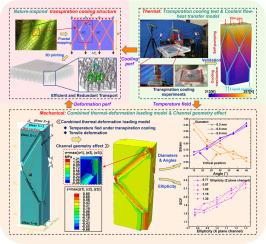Heat transfer and deformation mechanisms of a nature-inspired transpiration cooling system for deformable aircraft
IF 5.8
2区 工程技术
Q1 ENGINEERING, MECHANICAL
International Journal of Heat and Mass Transfer
Pub Date : 2025-09-29
DOI:10.1016/j.ijheatmasstransfer.2025.127881
引用次数: 0
Abstract
Plants cooldown by moving water from their roots to their leaves at no energy expense, uniformly and reliably. Can engineers mimic plants to deliver intelligent cooling systems for supersonic/hypersonic flight? Evidence here suggests that such an advancement is possible. We propose a radically new transpiration cooling concept which is inspired by nature and combines supreme characteristics: the coolant flow adjusts naturally to the external heat flux environment thanks to capillary forces and the system can deform excessively if rubber-based materials are used. Experiments on exemplary nickel-based cooling systems indicate that the peak solid temperature can be maintained below 130 °C at heat loads of 270 kW/m², attributable to an excellent convective cooling efficiency of 91 %. This efficiency is predicted to reduce to 54 % for the case of silicon rubber, suggesting that the system could provide efficient cooling in future deformable aircraft wings, if rubber-based walls with intricate cooling channels can be manufactured. Computational Fluid Dynamics (CFD) and Finite Elements (FE) analyses also indicate that the cooling performance and structural integrity of the proposed TPS can be improved by modifying cooling channel geometry. Our study will hopefully provide a steppingstone to developing nature inspired TPS for greener aerospace vehicles.

可变形飞机的自然激发蒸腾冷却系统的传热和变形机制
植物通过将水分从根部输送到叶片来冷却,而不消耗能量,而且是均匀可靠的。工程师能否模拟植物,为超音速/高超音速飞行提供智能冷却系统?这里的证据表明,这样的进步是可能的。我们提出了一个全新的蒸腾冷却概念,它的灵感来自大自然,并结合了最高的特点:由于毛细力,冷却剂流量自然地适应外部热通量环境,如果使用橡胶基材料,系统可能会过度变形。对镍基冷却系统的实验表明,在270 kW/m²的热负荷下,固体温度峰值可保持在130℃以下,对流冷却效率η= 91%。对于硅橡胶的情况,该效率预计将降低到η= 54%,这表明如果能够制造出具有复杂冷却通道的橡胶基壁面,该系统可以为未来可变形的飞机机翼提供有效的冷却。计算流体力学(CFD)和有限元(FE)分析也表明,通过改变冷却通道的几何形状,可以提高TPS的冷却性能和结构完整性。我们的研究有望为开发受自然启发的绿色航天飞行器TPS提供一个垫脚石。
本文章由计算机程序翻译,如有差异,请以英文原文为准。
求助全文
约1分钟内获得全文
求助全文
来源期刊
CiteScore
10.30
自引率
13.50%
发文量
1319
审稿时长
41 days
期刊介绍:
International Journal of Heat and Mass Transfer is the vehicle for the exchange of basic ideas in heat and mass transfer between research workers and engineers throughout the world. It focuses on both analytical and experimental research, with an emphasis on contributions which increase the basic understanding of transfer processes and their application to engineering problems.
Topics include:
-New methods of measuring and/or correlating transport-property data
-Energy engineering
-Environmental applications of heat and/or mass transfer

 求助内容:
求助内容: 应助结果提醒方式:
应助结果提醒方式:


